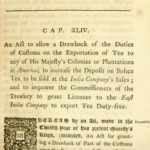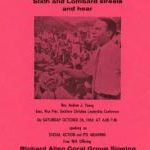Explore the role of third-party candidates and how the American political system makes it very difficult for anyone outside the Republican or Democratic Party to win the White House. Registration is required to view this resource.
Political Ideology in America: Bumper Sticker Politics
Americans love to personalize their vehicles in a way you will not see in many other countries. This lesson explores political ideology by analyzing data on automobile purchases and bumper stickers. Students will learn generalizations about conservatives, liberals, Democrats, Republicans, libertarians, socialists and appreciate the American custom of advertising political thought in public. Free registration required to access the lesson plan.
Causes of the American Revolution

This short video examines the Boston Tea Party of 1773 as the critical event which transformed political discussion about British imperial authority into an active source of controversy. By the early 1770’s, British and Americans thought differently about the extent of Parliament’s power to legislate for the American colonies. Professor Jack Rakove notes that British punishment of Massachusetts for its defiance of the Tea Act precluded a peaceful resolution of the political controversy.
Choice Board – How Effective Are Presidential Campaign Ads?
The methods in which candidates, political parties and interest groups promote their positions and policies have evolved since the first television campaign ads aired. In this lesson, students will view videos of historical presidential campaign advertisements and analyze the features found within each to determine the overall effectiveness.
The Constitution in Action – Political Parties and Presidential Electors: The Election of 1800
History is the chronicle of choices made by actors/agents/protagonists in specific contexts. This simulation places students in the Early Republic and asks them to engage in the politics of those times. Acting as either Federalists or Republicans, they will be asked to develop strategies for electing their party’s standard bearer as president, using the Constitution’s complex system of presidential electors to their advantage.
Lesson Plan: Choice Board – Researching Your U.S. Senators
This lesson provides students with the opportunity to explore their members of the U.S. Senate and how they represent their constituents as a fundamental part of civic literacy.
The Constitution in Action: The Early Republic
This unit presents students with several such issues faced by Americans in the Early Republic as they tried to interpret and implement the Constitution. Lessons address “Origin of the Bill of Rights,” “Strict v. Loose Construction,” “Who Shapes Foreign Policy?” “State Challenges to Federal Authority: The Kentucky and Virginia Resolutions,” and “Political Parties and Presidential Electors: The Election of 1800.”
Civil Rights in Pennsylvania

Throughout the twentieth century, blacks in Pennsylvania employed numerous strategies to achieve the civil rights they deserved. Their efforts for to receive their rights began with a strategy of New Deal liberalism in the 1940s and 50s headed by prominent black leaders. When attempts to rewrite the laws using the established political system failed, black leaders encouraged more direct action, like boycotts and sit-ins. The movement quickly took on a black nationalist approach. Philadelphia became the perfect place for several Black Power conferences and home of the short-lived, though active, Black Panther Party.
Hoping for Unity, Fearing Rebellion
National conventions are supposed to be a show of party power and solidarity, but there’s always the potential for dissent. See how they have evolved and how they can impact candidates and the electorate. Registration on NewseumED is required to view resource.
Election 2016 Case Study: Entering the Race
In 2016, 22 people led the field of Republicans and Democrats running for president. They were joined by about 1,800 third-party, fringe and joke candidates. But is this field as open as it seems?